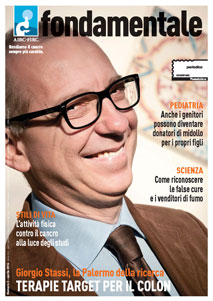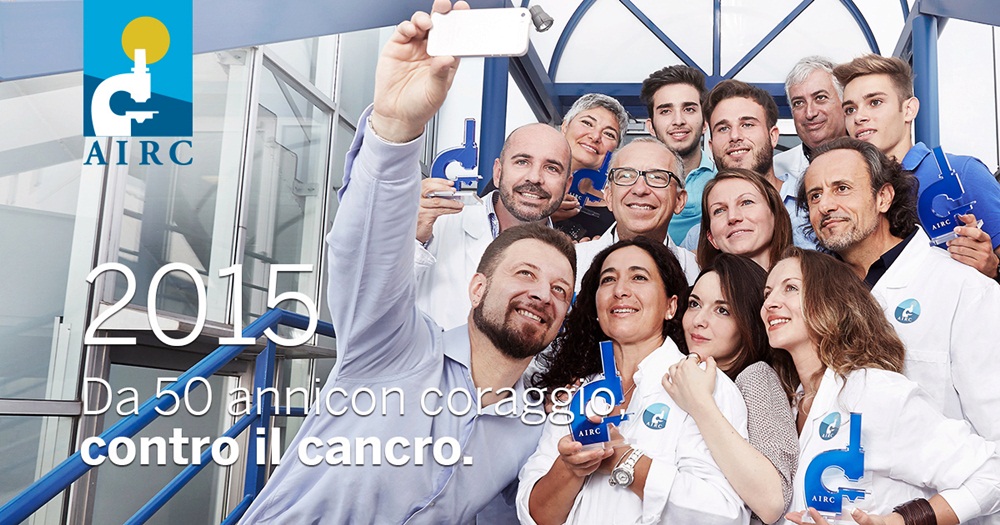Giorgio Stassi returned home to Palermo after having worked abroad and now, thanks to the 5- per-thousand project of AIRC, he found a key molecule, present in the cancer stem cells, on which to act to block the cancer metastasis of the colon.
The life of a researcher is usually marked by largely predictable events: the degree, the achievement of a postgraduate degree, perhaps abroad, the first article in an important journal, a teaching position. For some, however, they also touch on experiences of a different kind, which leave a mark: like when Giorgio Stassi understood that the explosion that had shattered the windows of the apartment in Tel Aviv was not due to an accident, but to a suicide terrorist attack, with dead and wounded, the first successfully carried out by Hamas in the heart of the city.
The Middle Eastern experience

In the Israeli capital Stassi had only been here for two days, and was a guest in the apartment lent by a colleague, just above the central department store Dizengoff, when the morning of the 19th of October 1994 a tremendous explosion at the bus stop caused the death of 22 people and injuring another 50, including children walking around the family. “I should have been at that stop,” recalls the researcher sitting in his study at the University of Palermo today. “Right after the explosion, my friend called me and told me to stay home. At the time I thought of returning immediately to Italy, but when I came down a few hours later to realize what had happened in person, as the only trace of what happened I found a large number of commemorative candles. I was struck by the fact that they had cleaned up everything and had even already put the new asphalt back on, to give a clear sign that life was going on “.
Thus he stayed to carry out a research at the Kaplan Hospital of the University of Tel Aviv on a family of Palestinians affected by a hereditary form of type 1 diabetes. In fact, he came from a specialization in endocrinology and diseases of the exchange, taken at the University of Palermo, under the guidance of Giandomenico Bompiani: “I have always been passionate about chemistry, and for a while I had thought that my career would be that” he recalls. “After graduating in medicine I chose endocrinology, because the group of Professor Bompiani, to whom I am still bound by a relationship of great esteem and affection, was known for the good level of research he carried out”.
At the fourth year of university he began his internship, dedicating himself to the research on transplanting pancreatic islets, the groups of cells that produce insulin: “I took care of the patients during the school of specialty, but then in the following years I was absorbed to 100% from laboratory research, “he explains.
These are the years in which he met his wife, Prof Matilde Todaro, married in 1993, with whom, after sharing the school of specialty, today divides the passion for research, the laboratory and the study on the ground floor, furnished with two desks and numerous shelves loaded with books. The walls are embellished with prints and reproductions of ancient paintings, among which the Lady with the ermine by Leonardo Da Vinci stands out. On a table in the corner, are placed two nets with the oranges of AIRC: “We owe a lot to AIRC: if it were not there I really do not know where Italian oncology would be today” emphasizes with a mixture of gratitude and pride “.
Oncology arrives in the USA
In Stassi’s professional life, the oncology would have entered some time after the Israeli experience: “After the two months spent in Tel Aviv I moved to Pittsburgh, in the United States, where with the group of Massimo Trucco, I contributed to studies not only on diabetes, but also on the mechanisms underlying autoimmune diseases, publishing in magazines such as Nature and Science. Just in Science, in 1997, a study appeared with my fraternal friend Ruggero De Maria, also known during his specialization in Palermo “. With De Maria, current scientific director of the National Cancer Institute “Regina Elena” of Rome, Stassi today participates in one of the great projects financed with the 5-per -thousand of AIRC. “After studying autoimmunity in the thyroid and pancreas together with him, I began to deal with thyroid cancer, being among the first to discover the cancer stem cells in that gland and, later – together with De Maria – those of the colon”.
In Pittsburgh, where Stassi had moved alone while his wife completed the school of specialty, life is marked by research in the laboratory and some travel to visit the beauty of America. “Going back to Palermo was not at all simple: the flight included three or four stopovers,” he recalls. This is why Matilde joins him immediately after her specialization in 1997.
In the same year the stork knocks on the door: “Thinking about the imminent arrival of the first child we discussed a bit ‘and at the end we decided to return to Italy”. The decision is not taken lightly, because even if Pittsburgh does not present the attractions of the native Palermo, the scientific perspectives are much more attractive than those that the couple expects to find at home.
It is at this point that the main object of the research becomes cancer: the arrival in cancer research is sealed in 1998 by a period spent in Rome, at the Department of Hematology and Oncology of the Higher Institute of Health, directed by Cesare Peschle. There Stassi initially deals with hematological tumors, and then focus on cancer stem cells: “The definition of stem cells, for these cancer cells, could generate a bit ‘of confusion, so much so that in the past it has been discussed at length on the opportunity to look for a different definition “, explains the researcher from Palermo. “These are cells that initiate the tumor and for this reason they are responsible for relapses, because when after an operation there are still very small quantities they are sufficient to restart the tumor growth”.
The beach house
From the period in Rome, when he lived near Piazza Vescovio and moved by public transport, he kept a fantastic memory: “It’s a splendid city. It is as if it were my home “. After just over a year the Roman experience ends, and Stassi has the opportunity to return to live in Palermo, in the villa of Mondello a stone’s throw from the beach. In 2003, when the firstborn Umberto is six years old, Constance is born.
“Over the weekends I relax taking care of the garden, which always needs so much care, and all the housework. I do very well the plumber and the carpenter “he says with a smile. “I almost never cook, but on Sundays I make pancakes and occasionally some sweets”. The beach, too chaotic in the hot season, is very pleasant outside the season. “Without umbrellas and deck chairs it is splendid. Starting in October I go with my son, who loves windsurfing and makes regattas and free style. When there is good wind for him we do an hour’s drive and we all go to Mozia, near the salt marshes of Marsala, where there is a natural lagoon with a very shallow seabed and can have fun in complete safety “.
From the counter to the patient
Life at the university is marked by the morning appointment of the “kiosk” at 8.30: “Every day one of the boys in the workshop – 20 scholarship holders, students, PhD students and PhDs, mostly biotechnology graduates – exhibit at all a research of which he read on some of the magazines that he regularly follows, so we discuss them all together and keep up-to-date. ” The meeting takes place in a large hallway covered with tall metal cabinets, at the base of the stairs that go down to reach the workshop, at the basement level: the visitor is welcomed by a friendly multi-faceted and multicolored array of chairs each with its own distinct personality. The informality of places and furnishings – which in the real workshops leave room for cutting-edge equipment – goes well with the custom to celebrate every important step in the scientific career of each (the first published article, the degree, the doctorate , the first research published as first author) carrying a tray of sweets. Considering the frequency with which this happens – and the mastery and generosity of Sicilian confectioners – the joke that recurs among the boys is that this is not the right laboratory for those who want to keep the line.
The most recent celebration concerns a study that was published in the prestigious journal Cell Stem Cell, on a molecule that appears crucial in the onset of colon cancer metastasis. “In the preclinical studies the use of a drug that acts on this molecule has been shown to work very well, so much so that we have proposed its use as an adjuvant therapy in colon tumors”. His son Umberto, who attended the scientific high school with the idea of enrolling in mechanical engineering, contributed to the publication: “As he draws very well, I asked him to illustrate the mechanism we discovered, using the standard car metaphor that , when it is retouched in a particular environment, it turns into a racing car, escaping control and giving rise to metastasis. Now we hope that the next phase of clinical experimentation will confirm these results, which are very encouraging, even in patients “. Last 7th of February, at a meeting of the 5-per-thousand AIRC program, of which his group is part, it was decided that the experiment conducted in Palermo has a good chance of working on humans and therefore soon the first patients.
A cure for chemioresistance
In the Laboratory of cellular and molecular physiology of the Department of Surgical and Oncology disciplines of the University of Palermo, also known as “Stassi Lab“, we study the mechanisms that regulate the survival and resistance of cancer cells to conventional therapies, in particular in colon, lung and breast cancer.
The group participates in the special program of molecular clinical oncology 5-per-thousand AIRC, contributing primarily to the expansion of the collection of cancer stem cells (CSCs, from the English abbreviation Cancer Stem Cells) of colon and lung, cataloged and stored in the biobank of Higher Institute of Health in Rome. In particular, this program deals with: 1) the collection and treatment of tumor samples from which the cancer stem cells are extracted and isolated, and 2) the sending of the derived cell lines to the biobank accompanied by a large number of clinical and genetic information very useful for all future research on these tumors.
Another important line of research concerns a group of growth factors (called bone morphogenetic proteins, BMP) involved in the development of bone and cartilage and in the process of transformation of CSCs into tumor cells: these growth factors seem to have also a determining role in resistance to conventional therapies and in the appearance of relapses.
Finally, the Stassi Lab deals with preliminary testing of the molecular targets identified by other research groups participating in the 5-per-thousand AIRC Program, directed by Prof Ruggero De Maria.
Source Airc.it


